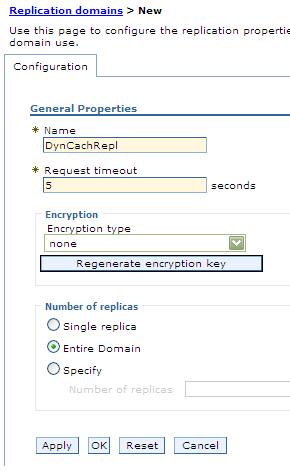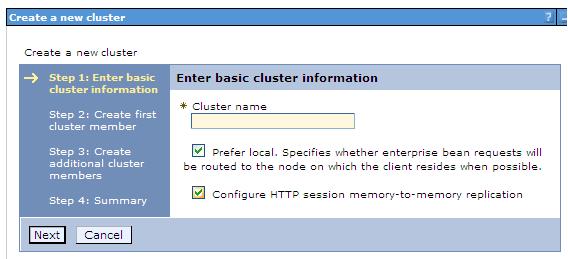Configure cache replication
Use this task to configure the data replication service (DRS) to replicate data from the dynamic cache service across the consumers in a replication domain.
You should have a replication domain created for the dynamic cache service. Configure a different replication domain for each type of consumer of the replication domain. For example, configure two different replication domains for dynamic cache and session manager.
There are two ways to configure replication domains:
- To create replication domains manually, click...
Environment | Replication domains

...in the console.
- To create a new replication domain automatically when you create a cluster, click...
Servers | Clusters | New

...in the console.
Do not use the default value of a single replica for the Number of replicas for dynamic cache replication domains. Instead, use a full group replica for any replication domains that you configure for dynamic cache.
If you configured cache replication with a previous version of WAS, review Migrating servers from multi-broker replication domains to data replication domains to learn about the new type of replication domains that you should use with the current version of WAS.
Overview
Use this task to improve performance in a clustered environment by enabling the DRS to replicate cached data across the servers in a cluster. Invalidations of cache entries are sent across the cluster to keep the cached data consistent and valid.
Procedure
- In the console, click...
Servers | Application servers | server | Container services | Dynamic cache service

- To enable replication, select Enable cache replication.
- Choose a replication domain.
Use different replication domains for each type of consumer. For example, dynamic cache should use a different replication domain than session manager. The only replication domains that you can select in this panel include replication domains that are configured to use full-group replication, where every cache entry is replicated to every other cache that is configured in the servers that are in the replication domain. If none of the replication domains in the configuration meet these requirements, the list is empty. In this case, create a replication domain or alter an existing replication domain so that you have a replication domain that can perform full-group replication.
- Define the dynamic cache replication settings.
Click Enable cache replication.
On this page, you can define when and how often data is replicated across the dynamic cache replication domain.
- Define sharing policies in the cachespec.xml file.
You can override the global sharing policy by specifying a specific sharing policy in the cache policy. For example, if your global policy is to use Push only, you can change the sharing policy of a specific cache entry by making this change to your cache policy:
<cache-entry> <sharing-policy>not-shared</sharing-policy> <class>servlet</class> <name>/app</name> <cache-id> <component id="action" type="parameter"> <value>portfolio</value> <required>true</required> </component> <component id="JSESSIONID" type="cookie"> <required>true</required> </component> <property name="EdgeCacheable">true</property> </cache-id> </cache-entry>
Results
Cache entries copy to the other appservers in the configured replication domain.
What to do next
Use the cache monitor to view the contents of the cache.Cache replication
Related tasks
Replicating data across appservers in a clusterTask overview: Using the dynamic cache service to improve performance